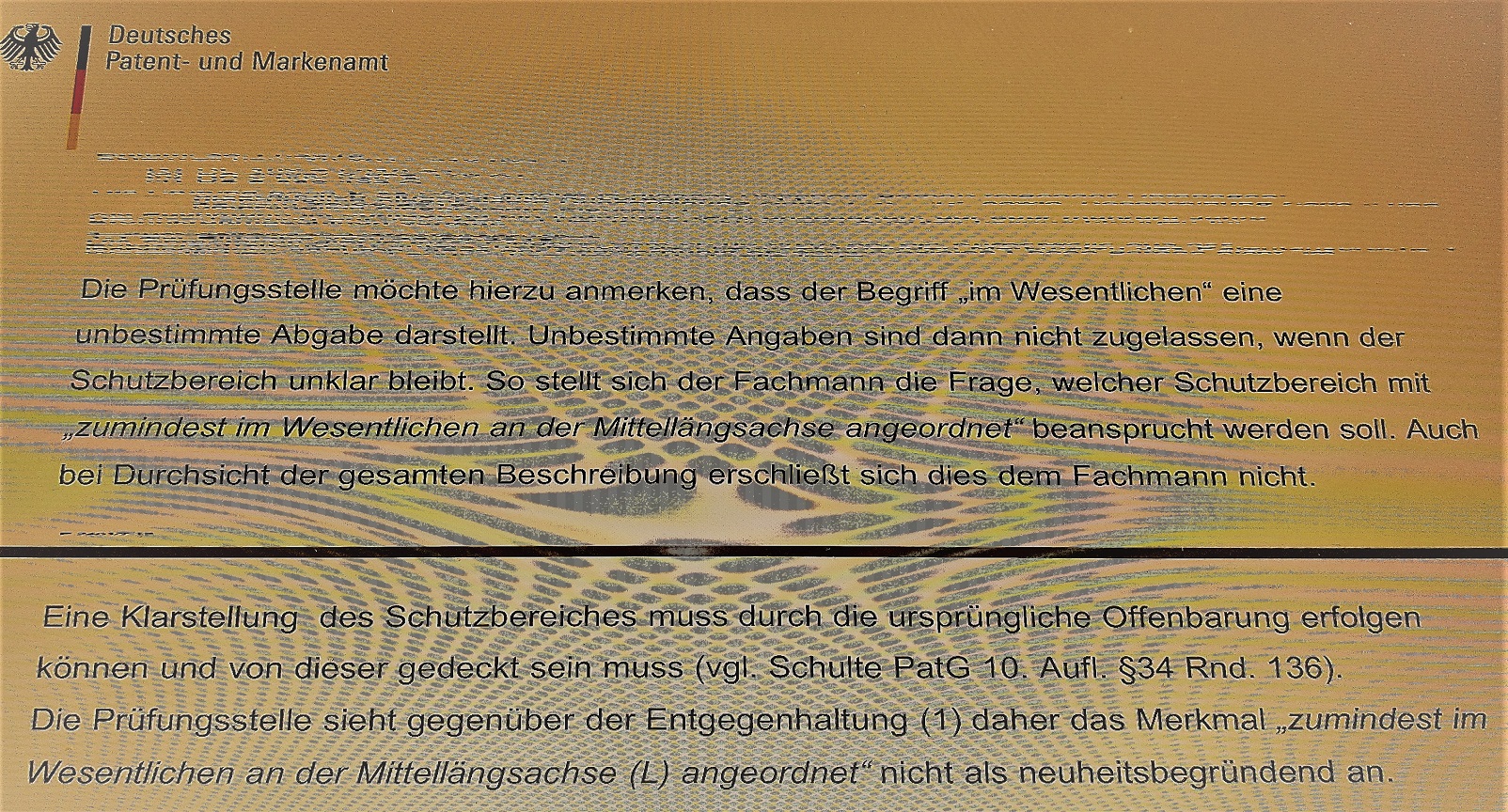– von Dr. Markus Petermann –
In Erteilungsverfahren beim DPMA wird der Begriff „im Wesentlichen“ oft als unklare Angabe im zu prüfenden Patentanspruch angesehen. Das reduziert nach Ansicht des Verfassers die Rolle des Fachmanns zu stark. In der BGH-Rechtsprechung finden sich Hinweise, die diese These stützen. Und wie unerwartet: das EPA verfolgt dazu einen sehr pragmatischen Ansatz.
I. Position der Prüfungsstelle
Zur Erwiderung auf den ersten Prüfungsbescheid in einem DPMA-Patenterteilungsverfahren war geltend gemacht, dass sich die Antriebswelle aus der relevanten Entgegenhaltung von den kennzeichnenden Merkmalen des Patentanspruchs 1 insbesondere dadurch unterschiede, dass der Schwerpunkt an beiden axialen Enden gerade nicht im Wesentlichen in der Längsachse der Antriebswelle liege.
Die Prüfungsstelle sah im zweiten Prüfungsbescheid in dem Begriff „im Wesentlichen“ eine unbestimmte Angabe, die dann nicht zugelassen sei, wenn der Schutzbereich unklar bleibt. So stelle sich der Fachmann die Frage, welcher Schutzbereich mit „zumindest im Wesentlichen an der Mittellängsachse angeordnet“ beansprucht werden solle. Auch bei Durchsicht der gesamten Beschreibung erschließe sich dies dem Fachmann nicht.
Aufgrund der unterstellten Unklarheit nehme eine Entgegenhaltung, bei deren Antriebswelle der Schwerpunkt explizit und aus zwingenden funktionalen Gründen nicht in der Längsachse der Antriebswelle liegt – mit anderen Worten das Gegenteil des beanspruchten Gegenstands – , die beanspruchte Erfindung vorweg. Aus der unterstellten Unbestimmtheit wird also darauf geschlossen, dass dadurch auch das Gegenteil gemeint sein kann.
Dieses Verständnis läuft nach Ansicht des Verfassers dem Konzept des fachverständigen Lesers der Patentanmeldung zuwider und kann daher nicht sachgerecht sein. Zumal die Wendung „zumindest im Wesentlichen“ in Ansprüchen gängige Praxis ist und eine Vielzahl von – auch deutschen – Patenten mit dieser Wendung erteilt wurden und werden.
II. Ansätze ausgehend von der BGH-Rechtsprechung
Nach dem Verständnis des Bundesgerichtshofs (BGH Kochgefäß – Urteil des X. Zivilsenats vom 13.1.2015 – X ZR 81/13) – allerdings aus einer Verletzungssache – ist die Wendung „im Wesentlichen“ dahingehend zu verstehen, dass von „einem praktisch noch erheblichen Maße“ die Rede ist (Rn. 25).
Zu ermitteln, was im Einzelfall ein praktisch noch erhebliches Maß ist, ist eine Aufgabe, die der Fachmann beim Lesen eines Patents in seiner Rolle als fachmännisch Verständiger automatisch erledigt. Mit einem solchen Verständnis macht aber die Wendung „im Wesentlichen“ einen Anspruch für den Fachmann – als Adressat der Offenlegungsschrift und ggf. der Patentschrift – auch nicht unbestimmt (vgl. zum fachmännischen Ansatz der Lektüre einer Patentschrift BGH Brieflocher – Urteil des X. Zivilsenats vom 7.11.2000 – X ZR 145/98 – S.8 unten bis S.9 oben).
Für den Verfasser sind keine Gründe erkennbar, warum das in BGH Kochgefäß Rn. 25 dargelegte Verständnis der Wendung „im Wesentlichen“ auf die Auslegung des Patentanspruchs im Erteilungsverfahren nicht angewendet werden sollte. Denn zu beurteilen, was „in einem praktisch noch erheblichen Maße“ ist, liegt genau im Kern der fachmännischen Einschätzung. Und diese hat der Fachmann bei der Lektüre des später erteilten Patentes ja zur Verfügung, sodass er nicht im Erteilungsverfahren vor einer derartigen Formulierung geschützt werden muss.
Festgemacht am eingangs präsentierten Beispiel wäre es folglich genau Gegenstand des fachmännischen Verständnisses, einzuschätzen, wie exakt aufgrund der Formulierung „im Wesentlichen“ der Schwerpunkt des steuerabtriebsfernen Wellenabschlusses an der Mittellängsachse angeordnet sein muss, damit praktisch von einem zentrierten Schwerpunkt auszugehen ist.
Dafür steht dem Fachmann zudem die Möglichkeit einer funktionsorientierten Auslegung zur Verfügung – so sieht es zumindest der Bundesgerichtshof (BGH Staubsaugerrohr – Beschluss des X. Zivilsenats vom 12.10.2004 – X ZR 176/02 – S.7 unten bis S.8 oben), wenn der Wortlaut „im Wesentlichen“ für sich kein fest umrissenes Verständnis erlaube

BGH Staubsaugerrohr – Beschluss des X. Zivilsenats vom 12.10.2004 – X ZR 176/02 – S.7 unten bis S.8 oben
Das funktionale Verständnis des Fachmanns von dem Merkmal ist aber nicht unbestimmt, wie sich wiederum deutlich am verwendeten Beispiel zeigt:
entweder der Wellenabschluss ist spezifisch für einen von der Mittellängsachse abweichenden Schwerpunkt ausgebildet; dann ist der Schwerpunkt funktional betrachtet nicht „im Wesentlichen“ an der Mittellängsachse angeordnet;
oder die Abweichung ergibt sich ohne Absicht (also ohne funktionale Begründung) aufgrund von Fertigungs- oder Montagetoleranzen o.ä.; dann ist der Schwerpunkt funktional betrachtet eben schon „im Wesentlichen“ an der Mittellängsachse angeordnet, wenn auch dann nicht exakt.
III. Ansatz aus den Richtlinien des EPA
Das EPA beschäftigt sich in seinen Prüfungsrichtlinien explizit mit der Wendung „im Wesentlichen“, und wendet eine pragmatische Auslegungsregel an (vgl. EPA Richtlinien für die Prüfung F-IV, 7.4.1):
Wenn Begriffe wie “im Wesentlichen” im Zusammenhang mit der strukturellen Einheit einer Vorrichtung (z. B. “Schalenplatte mit einem im Wesentlichen kreisförmigen Umfang” oder “Schalenplatte mit ungefähr kreisförmigem Umfang”) verwendet werden, sei der Ausdruck mit “im Wesentlichen” als technisches Merkmal auszulegen, das innerhalb der technischen Toleranzgrenzen des Herstellungsverfahrens hervorgebracht werde.
Beispielweise sei das Schneiden von Metall viel genauer als das Schneiden von Kunststoff und das Schneiden mit einer CNC-Maschine genauer als das Schneiden von Hand. Daher sei der Ausdruck “Schalenplatte mit einem im Wesentlichen kreisförmigen Umfang” sei so auszulegen, dass er dasselbe technische Merkmal beansprucht wie “Schalenplatte mit kreisförmigem Umfang”; mit beiden Ausdrücken werde eine Platte beansprucht, deren Boden der Industriefachmann als rund betrachten würde.
Auch im Prüfungsverfahren vor dem EPA wird also auf ein fachmännisches Verständnis rekurriert, das keinen Raum für eine Unbestimmtheit der Wendung „im Wesentlichen“ lässt.
IV. Lessons learned
Während im EP-Erteilungsverfahren die Wendung „im Wesentlichen“ pragmatisch ausgelegt wird, scheiden sich im deutschen Verfahren die Geister daran. Obwohl vielfach verwendet, werden entsprechende Gegenstände teilweise erteilt, teilweise wegen Unbestimmtheit gerügt oder zurückgewiesen.
Beim Verfassen von Patentanmeldungen und der Änderung von Ansprüchen verbleibt die Frage, ob man „im Wesentlichen“ verwenden soll, um den Gerichten in der Verletzungsauslegung deutlich vor Augen zu führen, dass der Gegenstand nicht eng ausgelegt werden soll. Oder nicht, um ein mögliches Hindernis in der Erteilung auszuräumen. Die hier vorgestellte Argumentation kann vielleicht helfen, die gewünschte Auslegung für das erteilte Patent mit einem geringeren Aufwand im Erteilungsverfahren zu verbinden.
Die Anwälte bei PAUSTIAN & PARTNER werden jedenfalls weiterhin Ihre Köpfe auch zu solch vermeintlich kleinen Fragen bei Anmeldungsentwürfen und in der Prosecution rauchen lassen, um für ihre Mandanten möglichst durchsetzbare und wertvolle Schutzrechte zu erreichen.

